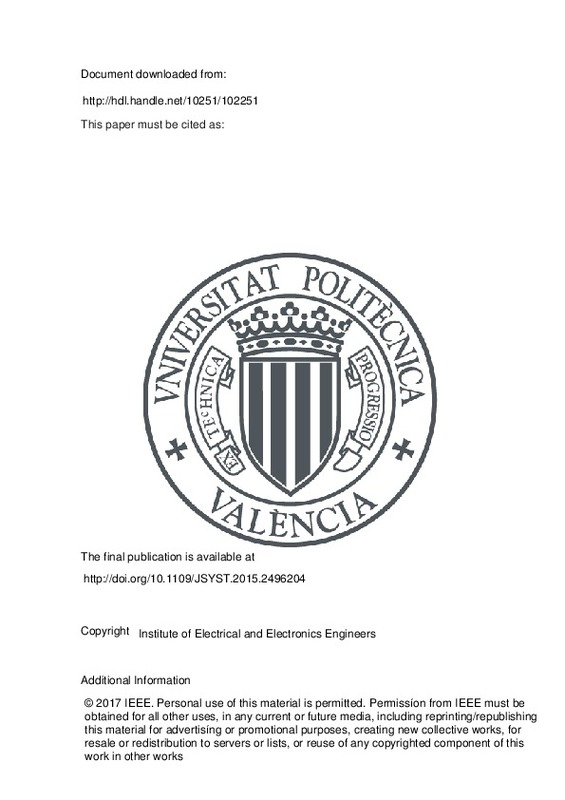JavaScript is disabled for your browser. Some features of this site may not work without it.
Buscar en RiuNet
Listar
Mi cuenta
Estadísticas
Ayuda RiuNet
Admin. UPV
Improving the Signal Propagation at 2.4 GHz Using Conductive Membranes
Mostrar el registro sencillo del ítem
Ficheros en el ítem
| dc.contributor.author | Parra-Boronat, Lorena
|
es_ES |
| dc.contributor.author | Sendra, Sandra
|
es_ES |
| dc.contributor.author | Vincent Vela, Maria Cinta
|
es_ES |
| dc.contributor.author | García Gabaldón, Montserrat
|
es_ES |
| dc.contributor.author | Lloret, Jaime
|
es_ES |
| dc.date.accessioned | 2018-05-19T04:21:14Z | |
| dc.date.available | 2018-05-19T04:21:14Z | |
| dc.date.issued | 2017 | es_ES |
| dc.identifier.issn | 1932-8184 | es_ES |
| dc.identifier.uri | http://hdl.handle.net/10251/102251 | |
| dc.description | © 2017 IEEE. Personal use of this material is permitted. Permissíon from IEEE must be obtained for all other uses, in any current or future media, including reprinting/republishing this material for advertisíng or promotional purposes, creating new collective works, for resale or redistribution to servers or lists, or reuse of any copyrighted component of this work in other works | |
| dc.description.abstract | [EN] When IEEE 802.11 at 2.4-GHz signal crosses different surfaces, it is generally reduced, but we have seen that it does not happen for all materials. Conductive membranes are able to transport electric charges when they are submerged into water with electrolytes, so we take profit of their features in order to know in which cases the received signal strength indicator (RSSI) can be improved. In order to achieve our goal, the RSSI is measured at different distances using different environments for the membranes, air, and water environment with different conductivities (distillated water, tap water, and salty water). Results show that different membranes environment produce different signal strengths. Moreover, they can be positive or negative depending on the environment of the membranes and the distance from the access point. In some cases, we registered an increase of more than 14 dBm of the signal when we were using those membranes. | es_ES |
| dc.description.sponsorship | This work was supported in part by the "Ministerio de Ciencia e Innovacion," through the "Plan Nacional de I+D+i 2008-2011" in the "Subprograma de Proyectos de Investigacion Fundamental," project TEC2011-27516. | |
| dc.language | Inglés | es_ES |
| dc.publisher | Institute of Electrical and Electronics Engineers | es_ES |
| dc.relation.ispartof | IEEE Systems Journal | es_ES |
| dc.rights | Reserva de todos los derechos | es_ES |
| dc.subject | Conductive membranes | es_ES |
| dc.subject | Received signal strength indicator (RSSI) | es_ES |
| dc.subject | Water environment | es_ES |
| dc.subject | Wireless networks | es_ES |
| dc.subject | Wireless signals propagation. | es_ES |
| dc.subject.classification | TECNOLOGIA DEL MEDIO AMBIENTE | es_ES |
| dc.subject.classification | INGENIERIA QUIMICA | es_ES |
| dc.subject.classification | TECNOLOGIA ELECTRONICA | es_ES |
| dc.subject.classification | INGENIERIA TELEMATICA | es_ES |
| dc.subject.classification | TEORIA DE LA SEÑAL Y COMUNICACIONES | es_ES |
| dc.title | Improving the Signal Propagation at 2.4 GHz Using Conductive Membranes | es_ES |
| dc.type | Artículo | es_ES |
| dc.identifier.doi | 10.1109/JSYST.2015.2496204 | es_ES |
| dc.relation.projectID | info:eu-repo/grantAgreement/MICINN//TEC2011-27516/ES/RED COGNITIVA BASADA EN GRUPOS DE SENSORES COLABORATIVOS PARA EL SENSADO Y MONITOZACION DEL ENTORNO ACUATICO/ | es_ES |
| dc.rights.accessRights | Abierto | es_ES |
| dc.date.embargoEndDate | 2018-12-31 | es_ES |
| dc.contributor.affiliation | Universitat Politècnica de València. Departamento de Comunicaciones - Departament de Comunicacions | es_ES |
| dc.contributor.affiliation | Universitat Politècnica de València. Departamento de Ingeniería Química y Nuclear - Departament d'Enginyeria Química i Nuclear | es_ES |
| dc.contributor.affiliation | Universitat Politècnica de València. Instituto de Investigación para la Gestión Integral de Zonas Costeras - Institut d'Investigació per a la Gestió Integral de Zones Costaneres | es_ES |
| dc.description.bibliographicCitation | Parra-Boronat, L.; Sendra, S.; Vincent Vela, MC.; García Gabaldón, M.; Lloret, J. (2017). Improving the Signal Propagation at 2.4 GHz Using Conductive Membranes. IEEE Systems Journal. 11(4):2315-2324. https://doi.org/10.1109/JSYST.2015.2496204 | es_ES |
| dc.description.accrualMethod | S | es_ES |
| dc.relation.publisherversion | http://doi.org/10.1109/JSYST.2015.2496204 | es_ES |
| dc.description.upvformatpinicio | 2315 | es_ES |
| dc.description.upvformatpfin | 2324 | es_ES |
| dc.type.version | info:eu-repo/semantics/publishedVersion | es_ES |
| dc.description.volume | 11 | es_ES |
| dc.description.issue | 4 | es_ES |
| dc.relation.pasarela | S\357867 | es_ES |
| dc.contributor.funder | Ministerio de Ciencia e Innovación | es_ES |







![[Cerrado]](/themes/UPV/images/candado.png)

